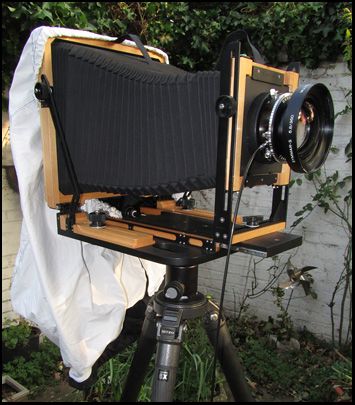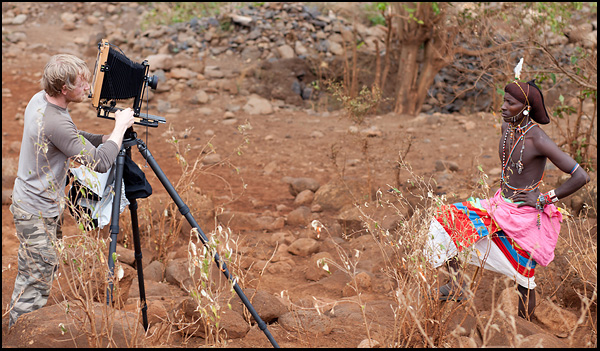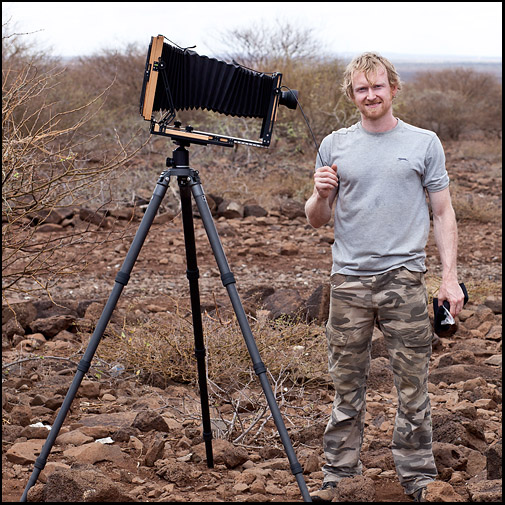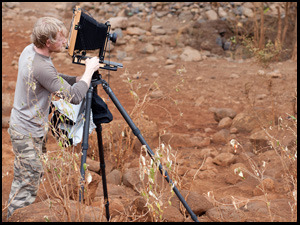My recent time in Northern Kenya has involved a real departure from my working methods of the past. In January this year I received this Chamonix 10x8 large format film camera:

My work in Africa is in many ways involves an attempt to capture and reproduce tangible aspects of tradition that permeate certain groups on this huge continent; and in particular how traditions are represented visually through each person’s attire and their look. I may see this in different terms to how others would interpret it, but with some people I feel that I can see their whole way of living etched into their faces and their behaviour. Theirs is a way of life that is deeply and inextricably linked to the rigours of the physical landscape: inescapable challenges of both terrain and climate. Seeing, and feeling this is a vitally important part of the passion that leads me to making each one of my pictures.
What does tradition mean in my own way of life, and in what I do? And is it possible to experience mutual fascination for tradition - with the people I encounter - when I travel in Northern Kenya? Well it would of course be impossible to show those that I photographed a direct equivalent of their lengthy traditional lineage from my own society - certainly not represented through my own look. However I can tell you that the working practice of photographing with this traditional large format camera amongst Northern Kenyan societies provided equal parts entertainment to the same measure of fascination for all onlookers. Some amazement, some laughter; almost never a reaction of ambivalence. I just wish that I had taken a picture of one of my subjects peering through the camera when I took the lens off the front whilst packing up the gear: each person was mesmorised that this object that had demanded complete concentation over a prolonged period from both of us - well - 'It has nothing inside...it's....it's just a box!'

For some time I have felt like I wanted to experience the craft of photography in a new, far more involved way (in this context 'new' is a paradox, as 10x8 film is photography in its practically oldest guise). The format is called 10x8 - or 8x10 in the U.S - as the size of each shot of film is ten by eight inches. That's not far off a sheet of A4 paper: pretty huge. It's also very, very expensive so you don't want too many blinks in your portraits at between £3 and £10 a shot of film (that's before developing costs). But if the Gods line up in an auspicious way, you have a picture on film that will need very little enlargement in order to make an enormous print. The quality of one of these images is still unparalelled, even in this day and age of advancing digital technology. Many of my absolute photographic heroes used this format - including Ansel Adams, Edward Weston and Richard Avedon.
So February and March were spent experimenting in London with the camera and I was left with some tangible failures, some successes, and a constant reminder of the constraints of this beautiful and difficult format. I experienced a number of costly light leaks which were truly maddening and forced me to re-examine every step of film handling and picture taking. I took a brave call in late March that I was going to take this heavy camera with 15 boxes of film (150 shots) and 5 film holders with me on the road into the extreme heat and dust of Northern Kenya. In the final days before leaving I narrowed the light leak problem to the 'light tight' slit of my film holders (they are supposed to be light tight - but they are not). Phew! It's worth mentioning too that I had to hitch across Northern Kenya with this heavy gear so it was also a real physical challenge.
Well, on the other side of the trip, I can tell you that it was an absolute blast travelling with 10x8 and - with the same breath - I can also say it was absolutely exhausting to make my working debut in such a harsh, rugged environment. And yes, I did take my smaller digital camera because I had frankly no idea whether every single one of my pictures might get light fogged somewhere along the way. The first sheets have now been developed and they are looking fine so I'll keep my fingers crossed for the rest.
So how was the experience of trying to make my portraits out there with this gear?
In short: much, much harder than with my digital gear. But fun too - a real experience for both me and the subject. I can assure you that at times I had some crowds watching the mad Englishmen working this big contraption. So precisely what makes this thing harder than shooting digital? Well, everything you can think of (and more besides). Everything needs to be set manually - and often reset multiple times - as your subject's behaviour adapts. And I was always struggling to find enough light when shooting in shade with my measly 100 speed film (the only affordable film I could get my hands on was Provia 100 slide film - which I 'pushed' to 200 speed). Shutter speeds were always slow...with f stops too wide...and people rock back and forth between focussing the image and inserting the film in a way that will loose your carefully attained picture focus in a heartbeat. And of course you can't see the picture composition when you actually press the shutter release cable. Pray that the person doesn't blink! Without an assistant these challenges are very tricky to negotiate - not least in the windy, baking Kenyan desert - but I started this trip aware of all these problems and, I hope, did my best to adapt my working practices to give me a chance of success. So I am hopeful that there may be some beautiful things to discover as my sheets get processed one by one as I write this (May 10, 2011). Fingers well and truly crossed - because I worked damned hard to get these shots!
'Next up, Ethiopia', I guess.

